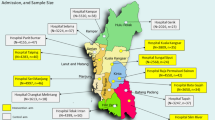Abstract
Background
With substantial morbidity and functional impairment, older patients receiving home health care are especially susceptible to the adverse effects of unsafe or ineffective medications. Home health agencies’ medication review and reconciliation services, however, provide an added mechanism of medication safety that could offset this risk.
Objective
To estimate the prevalence of potentially inappropriate medications (PIMs) among current elderly home health patients in the US.
Design
Cross-sectional analysis using data from the 2007 National Home and Hospice Care Survey.
Subjects
3,124 home health patients 65 years of age or older on at least one medication.
Main Measures
Prevalence and classification of PIM use and the association between PIM use and patient and home health agency characteristics.
Key Results
In 2007, 38% (95% CI: 36–41) of elderly home health patients were taking at least one PIM. Polypharmacy was associated with an increased risk of PIM use; admission to home health care from a nursing home or other sub-acute facility (compared to admission from the community) and a payment source other than Medicare or Medicaid were associated with a decreased risk of PIM use.
Conclusions
The prevalence of PIM use in older home health patients is high despite potential mechanisms for improved safety. Policies to improve the review and reconciliation processes within home health agencies and to improve physician-home health clinician collaboration are likely needed to lower the prevalence of PIM use in older home health patients.
Similar content being viewed by others
References
Medicare Payment Advisory Commision. Heath Care Spending and the Medicare Program: A Data Book. 2010.
Centers for Disease Control and Prevention. National Center for Health Statistics. Home Health Care Patients: Data from the 2000 National Home and Hospice Care Survey. 2004 [updated 2004; cited 2011 September 16]; Available from: http://www.cdc.gov/nchs/pressroom/04facts/patients.htm.
Beers MH. Explicit criteria for determining potentially inappropriate medication use by the elderly. An update. Arch Intern Med. 1997;157(14):1531–6.
Fick DM, Cooper JW, Wade WE, Waller JL, Maclean JR, Beers MH. Updating the Beers criteria for potentially inappropriate medication use in older adults: results of a US consensus panel of experts. Arch Intern Med. 2003;163(22):2716–24.
Goulding MR. Inappropriate medication prescribing for elderly ambulatory care patients. Arch Intern Med. 2004;164(3):305–12.
Viswanathan H, Bharmal M, Thomas J. Prevalence and correlates of potentially inappropriate prescribing among ambulatory older patients in the year 2001: comparison of three explicit criteria. Clin Ther. 2005;27(1):88–99.
Lau DT, Kasper JD, Potter DE, Lyles A. Potentially inappropriate medication prescriptions among elderly nursing home residents: their scope and associated resident and facility characteristics. Health Serv Res. 2004;39(5):1257–76.
Meurer WJ, Potti TA, Kerber KA, Sasson C, Macy ML, West BT, et al. Potentially inappropriate medication utilization in the emergency department visits by older adults: analysis from a nationally representative sample. Acad Emerg Med. 2010;17(3):231–7.
Center for Medicare and Medicaid Services. Outcomes and Assessment Information Set (OASIS-C) Process-Based Quality Improvement (PBQI) Manual. Rockville, MD; 2010.
National Center for Health Statistics. 2007 National Home and Hospice Care Survey and National Home Health Aide Survey, Survey Documentation. Hyattsville, MD; 2009.
Cerner Multum Inc. Lexicon. [cited 2011 September 16]; Available from: http://www.multum.com/Lexicon.htm.
Buck MD, Atreja A, Brunker CP, Jain A, Suh TT, Palmer RM, et al. Potentially inappropriate medication prescribing in outpatient practices: prevalence and patient characteristics based on electronic health records. Am J Geriatr Pharmacother. 2009;7(2):84–92.
Cannon KT, Choi MM, Zuniga MA. Potentially inappropriate medication use in elderly patients receiving home health care: a retrospective data analysis. Am J Geriatr Pharmacother. 2006;4(2):134–43.
Meredith S, Feldman PH, Frey D, Hall K, Arnold K, Brown NJ, et al. Possible medication errors in home healthcare patients. J Am Geriatr Soc. 2001;49(6):719–24.
Fialova D, Topinkova E, Gambassi G, Finne-Soveri H, Jonsson PV, Carpenter I, et al. Potentially inappropriate medication use among elderly home care patients in Europe. JAMA. 2005;293(11):1348–58.
Gray LK, Cozmin L, Esenwine J. Improving home care A survey on physician and nurse communication. Home Care Provid. 1998;3(2):100–3.
Fairchild D, Hogan J, Smith R, Portnow M, Bates D. Survey of primary care physicians and home care clinicians. J Gen Intern Med. 2002;17(4):253–7.
Kogan P, Underwood S, Desmond D, Hayes M, Lucien G. Performance improvement in managed long-term care: physician communication in managing community-dwelling older adults. Home Healthc Nurse. 2010;28(2):105–14.
Home Health Quality Improvement National Campaign. Evaluation Shows Home Health Agencies Working Hard to Improve Medication Management. 2010 [updated 2010; cited 2011 September 16]; Available from: http://www.homehealthquality.org/shared/content/hhqi_campaign/MMSurveyResults.pdf.
Budnitz DS, Shehab N, Kegler SR, Richards CL. Medication use leading to emergency department visits for adverse drug events in older adults. Ann Intern Med. 2007;147(11):755–65.
Acknowledgment
This study is funded by the National Institute of Mental Health (YB, HS: R03MH085834, K01MH090087; YB, BRS, MLB: P30MH085943).
Martha Bruce, Ph.D., has served as a consultant to Medispin, Inc., a medical education company.
Conflict of Interest
None
Author information
Authors and Affiliations
Corresponding author
Rights and permissions
About this article
Cite this article
Bao, Y., Shao, H., Bishop, T.F. et al. Inappropriate Medication in a National Sample of US Elderly Patients Receiving Home Health Care. J GEN INTERN MED 27, 304–310 (2012). https://doi.org/10.1007/s11606-011-1905-4
Received:
Revised:
Accepted:
Published:
Issue Date:
DOI: https://doi.org/10.1007/s11606-011-1905-4




